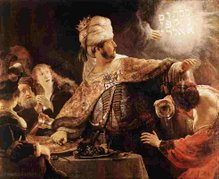
Rembrandt's "Belshazzar's Feast"
Sunday, August 5, 2007
Gesamtkuntswerk in Museum Form
Denver Art Museum is a wonderful demonstration of sensory connectedness. I have been exploring ideas for teaching literature as a sensory involvement beyond the visual, and this forward-thinking museum shows how many areas might be involved in any exploration of ideas. The approach visually goes beyond the artworks to incorporate their presentation, with each room painted in a bold, rich color—no faded pastels here—but strong, forceful use of color. It is quite effective, so much more pleasing than the standard white walls of museums. The approach to audience involvement is engaging on all levels, reaching beyond standard descriptive biography in the wall mounted textual explanations to effectively discuss elements of the arts presented. One room focuses on character in painting while another dwells on place, noting that the same place painted by different artists is shaped by the painter.
One particular artist of interest in a discussion of sensory engagement in artistic production painted in the sixteenth century, but his ideas entertain today. The works employ natural forms to paint something unrelated in subject. Denver holds a portrait of a man and a woman by the Italian artist constructed of fruits and vegetables with all the implied hints of taste and smell (the natural science museum which I strolled earlier in the day had offered buttons to emit scents given off as signals by animals). I was beginning to feel that I was part of a bigger movement in my efforts to study a subject through sensory exploration.
The staff offered help and suggestions, pointing out a book in the attached reading room on the Italian artist who interested me. Such reading rooms were scattered throughout the museum with one featuring comfortable sofa and overstuffed chairs, a computer, drawers to explore filled with educational artistic materials, bookmarks at no charge – one listing the favorite reference texts of artist, another discussing gilding in art. The walls are filled with bookshelves inviting visitors to expand their artistic exploration. From its architecture by Daniel Libeskind to its audience involvement, the museum challenges in new ways, asking for a response.
I continually gasped exclamations to my daughter at the magnificent job the museum had accomplished, nearly crying when I saw the largest library room—overwhelmed by the attention to detail and the effort to engage the audience. Using the ladies room on leaving, I was entertained by a final sensory tactic as the faucets sand when water flowed, each I discovered in a different voice, the 2002 accomplishement of artist Jim Green, appropriately entitled “Singing Sinks.” The artist is present in this museum as a being, a partner in the production, in a way I had never experienced. A startling painting by Colorado artist Daniel Sprick, called “Release Your Plans,” is accompanied by a film covering a wall of the artist explaining that particular complex contemporary work. Another wall holds a self portrait of the artist.
Nearby is a studio filled with materials to create a card to send a friend, and the means to mail it onsite. A display of art from the American West incorporates a row of chairs with small tables in front of them, each holding a book entitled “What Does the West Mean to You?” Instructions are at hand to operate the Ipods filled with mood enhancing cowboy tunes for the audience to listen to while writing entries in the blank pages of the journals. No doubt, the responses will find a future use in the museum. Everywhere the engagement of audience is included in the presentation of the artworks. I am overwhelmed—thrilled to be on the same page! The senses are bombarded; artwork presented in an enhanced fashion to appeal to a wider audience.
Subscribe to:
Posts (Atom)